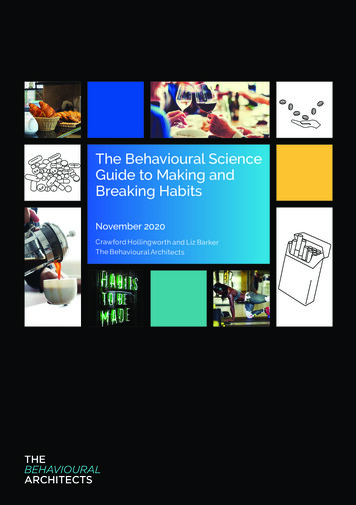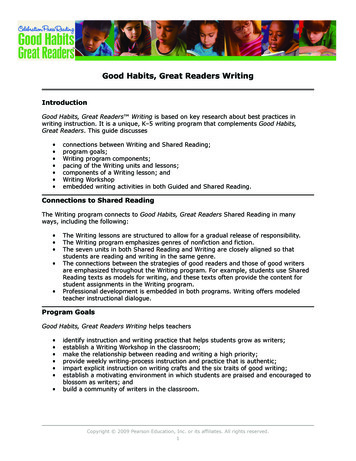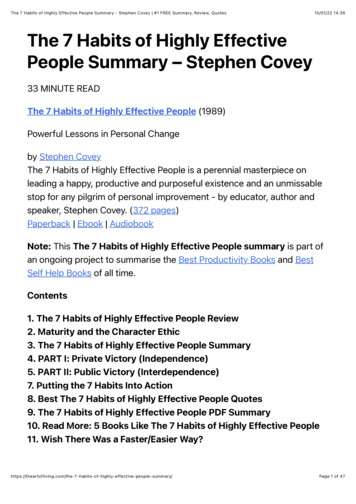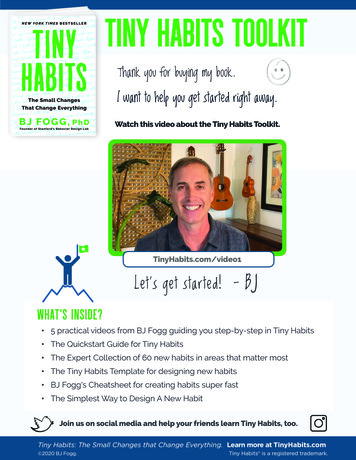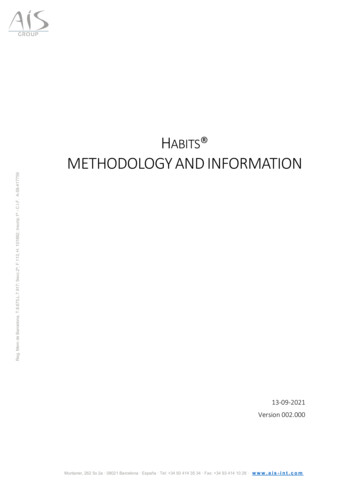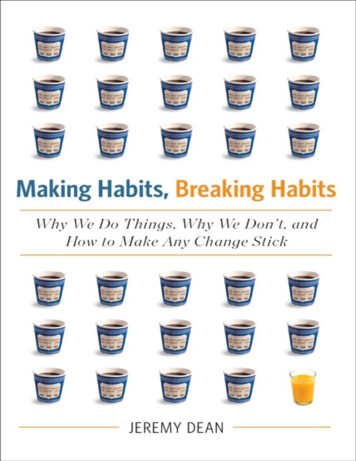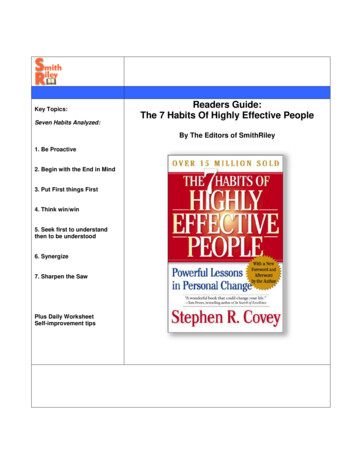
Transcription
Key Topics:Seven Habits Analyzed:Readers Guide:The 7 Habits Of Highly Effective PeopleBy The Editors of SmithRiley1. Be Proactive2. Begin with the End in Mind3. Put First things First4. Think win/win5. Seek first to understandthen to be understood6. Synergize7. Sharpen the SawPlus Daily WorksheetSelf-improvement tips
Author: The Editors of SmithRileyCopyright 2004All rights reserved. No part of this book, including interior design, cover design may be reproduced ortransmitted in any form, by any means (electronic, photocopying, recording, or otherwise) without thewritten permission of the publisher or author.ISBN: 0975453424Produced in the United States of America. Copyrighted works are protected by US law for life of authorplus an additional 70 years.For information such as technical questions, press inquiries, licensing, author interviews or otherinformation, please contact the publisher by email at smithriley@yahoo.com.Notice: The 7 Habits of Highly Effective People is a copyrighted work of Stephen R. Covey andFranklin Covey Co.Limit of Liability/Disclaimer or Warranty: The publisher and author have used best efforts inpreparing this book. The publisher and author make no representations or warranties withrespect to the accuracy or completeness of the contents of this book. This book includes nowarranty as to specific results and neither publisher nor author shall be liable for any damages orany loss of profit or any other commercial damages. Author and publisher make no guarantee asto accuracy or websites linked to in this book.Designed for use with Adobe Reader 6 and higher versions. Adobe Reader is trademark of AdobeCorporation.
Readers Guide: The 7 Habits of Highly Effective PeopleThis electronic book is written as a printable guide to be used while reading Stephen R. Covey’s The 7Habits of Highly Effective People book. This book was written for use with the first edition of the bookand has page numbers included that correspond with the book.IntroductionSeven Habits of Highly effective People seeks to create a paradigm shift. The definition of paradigm shiftis a change your perception, or to see things differently. The seven habits are a paradigm shift in thinkingand behavior.Principles and values. Principles are not values. “Principles are the territory. Values are maps.” Principlesare broad guidelines that apply to many different things.Inside out thinking is better than outside in thinking. Inside out thinking identifies your motives and beliefsand makes you responsible for your life. Outside in thinking is often negative thinking and blames othersand environmental factors for problems. This can lead to unhappiness and lead to person thinking thatthere is no way out of a situation. Outside in thinking has been occurring recently by financial companies.Companies report their quarterly earnings and blame bad weather or unexpected interest rate changesfor their company’s shortcomings.Habits DefinedA habit is the intersection of knowledge, skill and desire.Knowledge is the to do and why. Skill is the how to do. Desire is the motivation, the want to do. Happiness is the fruit of the desire and ability to sacrifice what we want now for what we wanteventually.The seven habits are habits of effectiveness.The seven habits are:1.2.3.4.5.6.7. Be ProactiveBegin with the End in MindPut First Things FirstThink Win/WinSeek First to Understand. Then to be UnderstoodSynergizeSharpen The SawHabits 1, 2 and 3 deal with self-mastery. Private victories precede public victories.Habits 4, 5 and 6 deal with teamwork, cooperation and communication.Habit 7 is the habit of continuous improvement.The Seven Habits are in harmony with natural law (P/PC Balance) The first P is Production, PC isProduction Capability. The story of P/PC balance is explained by using Aesop’s fable of the goose andthe golden egg. A poor farmer has a goose that lays golden eggs. He collects the golden eggs day afterday and becomes very wealthy. Then he gets greedy and kills the goose with hope of getting all thegolden eggs inside. He looks inside and finds nothing and has no opportunity to see any more goldeneggs because he has killed the goose. The egg (what is produced) is the production and the productioncapability is the goose. If one or the other is neglected, the natural harmony becomes unbalanced. If youReaders Guide: The 7 Habits Of Highly Effective People - Powerful Lessons in Personal Change3
stop feeding the goose, the eggs will stop coming because the goose will die. And if you focus only on thegoose, and not the golden eggs you won’t have the means to pay your bills.The natural equilibrium or P/PC is not a short term thing, but it is a long term balance. It may work in shortterm as well, but if short term solutions compromise long term P/PC then that is a poor choice. Anexample of a short term win would be a nightclub that waters down their drinks and sees a huge profitthat night. However, in the process the nightclub ticks off its customers and people stop coming back. Sothis short term win would lead to a long term loss or P/PC unbalance.P/PC balance is an investment in time or money in different areas so that things reach equilibrium.Satisfying both customers and employees is one example. Keeping yourself and your family happy isanother example.Habit 1 Be Proactive65Act or be acted upon. Proactive people act and are independently determined despite outsidedeterministic factors such as those below.There are three widely accepted theories of determinism: Genetic determinism - inherited personal tendencies and character.Psychic determinism - your upbringing and childhood experiences mold you.Environmental determinism - environmental factors are responsible.Proactive vs. Reactive. Proactive behavior is one based on individual responsibility vs. reactivedecisions based on the environment. Proactive people are their own weather. “Whether it rains or shinesmakes no difference to them.” A reactionary person’s mood is changed by the environment. If it is rainyhe/she may be sad and if it is sunny, they are happy.Proactives such as Gandhi kept striving forward despite negative environmental conditions such asimprisonment, beatings and fear of death. A proactive personality can look back and say to themselvesthat they are where they are because of the decisions they made. A reactionary may look back and saythat they are where they are because of what someone else did for them.This is not to say that proactives are right and reactionaries are wrong. Environmental conditions willalways be there but it is the individual’s perception to them that leads to an effective or ineffective result.Proactives tend to put their future in their own hands as opposed to putting their future into someoneelse’s hands.Use Correct Language:Reactive vs. Proactive language.Reactive:“I can’t”I have to do thatI must go to workProactive:“I choose”I choose to do thatI choose to go to workCircle of Concern/ Circle of Influence. The circle of concern are things which we may be concerned about.Some of them we can do things about while some things we can’t. Things within our circle of influenceare things within our grasp that we can change or influence. Outside this circle is a circle of concernwhich we cannot change or influence. For most of us things like interest rates and the president are in thecircle of concern. It may concern us but there is nothing we can do about it besides voting.Readers Guide: The 7 Habits Of Highly Effective People - Powerful Lessons in Personal Change4
The circle of influence is different for different people. A company CEO or chairman has a larger circle ofinfluence on the organization than a lower level employee.That is not to say that the circle stays the same size for everyone. Career advancements may lead to alarger circle. A greater investment in your child’s life may lead to an improving relationship with your childand have a greater influence on them.Inside the circle of influence are people. Our influence and relationships with these people is based on avariety of factors such as keeping commitments, honesty, and integrity.Activities:1. Spend a day focusing on the things that you say and what others around you say. Listen forreactive language such as “I can’t”, “I have to” etc and find proactive ways of saying things.2. Focus on circle of influence areas of your life and identify circle of concern. See if you can putsome things that are in areas of concern into your circle of influence. The things that you cannotput inside area of influence you should stop worrying about because it is needless worrying.Habit 2 Begin with End in Mind95Imagine what you want to accomplish in life and how you want to be remembered. Image yourself at yourown funeral. What would you want people to think of you? What accomplishments would you like to beremembered for? Think of these things and write them down on a piece of paper.The answers to the above will be a goal for you to achieve. Once you know the goal, you will be able tofigure out what it will take to achieve these goals. If you want to be a good father/mother husband/wifeyou will need to first know that you want this, and then take appropriate steps to achieve this goal. Alifetime goal will be something that most likely takes your entire life to achieve. It is not simply doingsomething once and expecting that that goal is done. It is something that takes many steps and repeatedsteps through the rest of your life. Spending time with loved ones and reacting with them favorably willmost likely take a large portion of one’s life.Establishing a personal mission statement is one way of expressing your goals for yourself. A personalmission statement doesn’t have to be just one thing, it can be many things.Personal Mission StatementsMaintain a positive attitudeBe a better fatherHear the facts before judging firstWork first, play laterThese are some examples of mission statements. They can even be put into paragraphs. Some thingsmay be areas which you are weak in and need to improve. You may also want to create a family missionstatement as well.In order to fulfill a successful mission statement, one needs three things: leadership - what do I want toaccomplish? The second is management – how can I accomplish it? The third is productivity – or doing it.The center of your life is an area of life which has the greatest influence on you. Mr. Covey breaks themdown into many different categories.Common Focus Centers1. Spouse Centeredness2. Family CenterednessReaders Guide: The 7 Habits Of Highly Effective People - Powerful Lessons in Personal Change5
3.4.5.6.7.8.9.Money CenterednessWork CenterednessPossession CenterednessPleasure CenterednessFriend/Enemy CenterednessChurch CenterednessSelf CenterednessThese are all different areas of centeredness that most people have. Spouse centeredness means yourfeelings are often determined by the relationship of spouse. Work centeredness ones feelings are relatedto ones position in company. Possession centeredness relies on possessions. The amount ofpossessions may affect ones feelings or actions. Pleasure centeredness seeks pleasure activities orleisure activities over other things. Friend/Enemy centeredness feelings are based upon our social circlesand relationships with friends. Enemy centeredness is center where one feels good/bad based upon howenemy feels and ways to get back at enemy. Church centeredness feelings are based upon churchposition or religious goals achieved. Self centeredness feelings are related to self and how things canimprove self.Management issues:Leadership is right brained activity that relies on philosophy and visualization. Management is doingthings right, leadership is doing the right things.Activities:1.2.3.4.Visualize your funeral and what you want people to say about you.Visualize your 25th wedding anniversaryVisualize your company 10yrs from nowVisualize the finish lineHabit 3 Put First Things First:145Principles of Personal ManagementThe Power of Independent Will The degree to which we have developed our independent will is measured by our personalintegrity.Integrity is the value we place on ourselves.Effective management is putting first things first.Four Generations of Time Management First Generation - Notes and checklistsSecond Generation - Calendars and appointment booksThird Generation – Current time management field - prioritization, of clarifying values, andcomparing the relative of worth of activities. Includes daily planning and goal setting.Fourth Generation – Not a focus on time but a focus on ourselves: preserving and enhancingrelationships and accomplishing resultsQuadrant II Urgent matters are usually visible. They press on us and stress action.Readers Guide: The 7 Habits Of Highly Effective People - Powerful Lessons in Personal Change6
Important matters contribute to our mission.Effective people stay out of Quadrants III and IV.Quadrant II is the heart of effective personal management.Many people mistakenly waste most of their time on Quadrant 1 activities by assuming that urgency andimportance is the same. An example of this is phone calls. They may often seem to be urgent becausethey require action. Often, however they are not important and they waste our time.Maximize your time. Balancing time between tasks so that P/PC is balanced. Time management Matrixorganizes activities into sections based on urgency level of importance.Avoid time wasters. Some phone calls, sales solicitations, and people are time wasters and areconsidered Quadrant 1 activities. Learn ways to eliminate or lower these time wasters. By organizingtasks into quadrants you can give some tasks the same sense of urgency you would get from a ringingtelephone.Organize and schedule ahead your daily tasks and choirs. Appointments and Commitments can beplaced under their own categories because they have to be arranged around other people. If you need tocancel a meeting you will need to call and reschedule. For many personal tasks, they do not have to becalled and be rescheduled because people aren’t involved in them.Delegate responsibility:One way of maximizing time is to delegate tasks to others that have time to do these tasks. Howeverdelegation without guidelines and accountability may have worse result than not delegating at all.Establish clear results desired, compensation, accountability and evaluation.Emotional Bank Acct:The emotional bank acct is sort of a tab that people keep on you for good things and bad things that youdo. It is a level of trust that you have with others. If your emotional bank acct is high with someone, youprobably have a good relationship with that person and will have a high circle of influence on that person.A low emotional bank acct with someone means the opposite. New relationships generally have a lowemotional bank acct, and low circle of influence.New relationships usually start with an emotional bank account balance of zero. However, friendsintroducing you to other friends or associates may give you an emotional bank account balance that isabove zero because your friend’s emotional bank account with that person is most likely in good standingand gives you a jump start because of your association with that person. As a result of this, new friendsor deals become easier to create because of this jumpstart effect. Social networking and personalreferrals is a system that has worked for a long time and is still widely used. A great example of this is thestatistic that approximately 76% of jobs in US are never published or advertised. New positions are simplyannounced to company employees who in turn tell their friends.Emotional bank account is similar to a regular bank account. It takes time to establish a high balance. Formost new people, they start out with a balance of zero and have to build up trust and the balance goesup. It also means that bank account can be overdrawn also. Asking for too many favors or violatingsomeone’s trust means that you may have overdrawn your emotional bank account and will have poorrelations with that person.Six major emotional bank deposits:1. Understanding the individual2. Attending to the Little thingsReaders Guide: The 7 Habits Of Highly Effective People - Powerful Lessons in Personal Change7
3.4.5.6.Keeping CommitmentsClarifying ExpectationsShowing Personal IntegrityApologizing Sincerely When you make a withdrawalUnderstanding the individual means finding similar interests or things that you can relate with for otherperson. Finding out the person’s interests or goals is very important. Without knowing the person, theother things are useless. Attending to the little things means understand the individual and takeoccasional actions or say occasional things that only someone that truly knows person could do. Keepingcommitments means not making promises that cannot be kept and showing up on time. ClarifyingExpectations is usually more of a business relationship thing. When negotiating for something it isimportant to layout what you want to accomplish and work out any concerns that the client may have.Showing personal integrity has to do with showing honesty and fulfilling expectations. Integrity goesbeyond just the individual. Doing things behind the backs of others in favor of one person is a violation ofintegrity. Apologizing sincerely when making a withdrawal has to do with making things right when you dowrong. Saying the wrong things or doing the wrong things must be followed up with apology if personfeels wronged.Habit 4 Think Win/Win204Six paradigms of human /LoseWinWin/Win or No dealInteractions with others will lead to the following six conclusions. The most desirable conclusion isWin/Win. In the short term, Win/Lose may be desirable but ultimately for most people Win/Win is the bestconclusion. Making friends generally takes time, so Win/Lose would probably mean that you areconstantly spending time making new friends to make up for the ones you have lost. And, with Win/Lose,you may have to spend time trying to straighten things out as a result of other person’s loss. So, thatmeans maintaining friendships with Win/Win is best use of time for most people over the long run and thisis done with Win/Win relationships or No deal.Lose/Lose is something that occurs when both parties waste time over something and nothing is won oneither side. A divorced couple that argues over payments and get nothing out of it is lose/lose for bothparties.Of course there are exceptions to Win/Win. Manmade games such as sports games generally shortenlifespan to a few hours and gives three conclusions, win, lose, or tie.Win/Win is the best, but if this cannot be achieved, no deal is good also. An example Mr. Covey mentionsis that he canceled a contract with client because client wasn’t comfortable or ready for deal. The clientthen came back later and signed an even bigger deal with Covey because he was happy with theprevious experience.Desired conclusions are in the eye of the beholder. This is based upon the mentality and character of theindividual. There are typically three character traits for win/win.Character Traits of Win/Win Conclusions:1. Integrity2. Maturity3. Abundance Mentality (as opposed to Scarcity Mentality)Readers Guide: The 7 Habits Of Highly Effective People - Powerful Lessons in Personal Change8
Integrity of a person is needed to figure out what is a win. Values must be known for an individual toknow what a win is.Maturity - High maturity is needed for win/win conclusions. Mr. Covey considers the meaning of maturityas a combination courage and consideration. Courage is the strength of one’s convictions andconsideration is the “long-term welfare of the other stakeholders.” Someone high on courage and low onconviction will want win/lose. High courage and consideration is needed for win/win.Abundance mentality is generally needed for win/win conclusion. This means that there is great deal ofopportunity for all people. The opposite is scarcity mentality. These people see limited opportunity outthere and the gain or win of one party is seen as a loss to the other. It is a sort of greed that secretly leadsto hopes that the other loses something. This thinking is created because a loss to the other party asseen as a gain to them. This type of negative thinking leads to hopes of a win/lose conclusion which is notgood. A win/win conclusion may be hard to fathom for someone with a scarcity mentality.The emotional bank account and relationships. A high emotional bank account balance may help withachieving most conclusions. Someone with a high emotional bank account balance will most likely haveexperience dealing with party and win/lose may even be acceptable by both parties because other partyhas trust with you and may know that favor will eventually be returned.Performance agreements. If compensation or rewards are not setup properly then win/win performancecan not be achieved. Asking an employee to do well at something without rewarding for it will not meanwin/win for employee and company. The objectives and systems must be in place for win/winperformance.Activities:1. Consider the relationships in your life and how your emotional bank account is with theserelationships.2. Work out a specific relationship where you would like to establish win/win conclusion. Work outwhat you consider a win for yourself and put yourself in other’s shoes and write down what isconsidered a win for them.3. Try figuring out how to turn a win/lose or lose/win relationship into a win/win relationship. Is theresomething that can be changed to make it a win/win conclusion?Habit 5 Seek First To Understand Then to be Understood235Character and Communication Communication is the most important skill in lifeListening is an often neglected form of communicationIf you want to interact effectively with people, to influence people, you first need to understand people.You have to build the skills of empathic listening on a base of character that inspires openness andtrust.Empathic ListeningEmpathic Listening is a deep listening where people listen to understand. Most people listen with intent toreply. This is not empathic listening. Listening with intent to reply focusing more on the reply than onunderstanding the other party. Empathetic listing focuses on listening without intent to manipulate.Readers Guide: The 7 Habits Of Highly Effective People - Powerful Lessons in Personal Change9
Empathic Listening is not sympathy. Sympathy is agreeing to the other party. You don’t have tosympathize with the other party in order to understand them. You are looking at things from your ownframe of mind and do not have to completely agree with the other party or sympathize with them.Sympathy is more of an agreement response to the other party. Sympathetic listening is not the same asempathic listening because with sympathy you are focusing on the response which is not good listening.Putting yourself into the other party’s shoes and thinking deeply from their point of view is a form ofempathic listening.Empathic listening can be risky because you become vulnerable to being influenced. In order to influenceyou have to be opened up to the possibility of being influenced. But that is what is necessary in order toget a win/win conclusions.Diagnose before you prescribeMake sure that both parties understand each other before trying to fit a solution. Getting details andspecifics about needs of a person is critical. Quick assumptions without understanding a person is notgoing to work out well. Mr. Covey uses the example of a doctor mistakenly prescribing medication withthe assumption that a person is a child rather than baby.People tend to respond in the following ways to conversations.Autobiographical Responses to conversations1.2.3.4.Evaluate (agree or disagree)Probe (ask questions from own frame of reference)Advice (give counsel based upon own frame of mind)Interpret (figure people out from own frame of mind)These things are often misused in communication and lead to poor interactions. This may especially betrue when adults are talking to children and say things like “when I was your age.” Telling a youngerperson that you have completed things often alienates them. A parent telling a child that they finishedschool doesn’t really help a child out that is trying to work out a current problem in school.Activities:1. Find a relationship where your Emotional Bank Account is in the negative. Try to understandbetter the other person’s point of view. On your next interaction with them compare yourassumptions and listen to see if your assumptions are accurate. Are you assumptions correct?2. Watch yourself the next time you interact with another for misusing autobiographical responses. Ifyou catch yourself doing this, ask if the person could repeat what they said and re-do yourresponses.Habit 6 Synergize261Synergy is defined by Covey as the whole is greater than the sum of its parts. Synergy is the sum of allthe habits coming together to make something great.Synergy and Communication – The highest level of communication is synergistic (win/win)communication. The lowest level of communication is one of low trust characterized by defensiveness,protectiveness, and legalistic language which may have escape clauses. The middle level ofcommunication is respectful communication -- where fairly mature people communicate but don’t reveleverything and don’t have complete trust.When synergy occurs special “moments” may occur that are hard to explain. It is a certain freedom andopenness and all of the other habits coming together for something truly great.Readers Guide: The 7 Habits Of Highly Effective People - Powerful Lessons in Personal Change10
Synergy values different opinions, viewpoints and perspectives from different people. Valuing differencesof others is a key component of synergy. Nature is synergistic.Synergy tips: Seek good in othersDon’t become negativeExercise courage in situationsExpress ideas, feelings and experiences with othersEncourage others to open upDon’t take insults personallyHabit 7 Sharpen the Saw287Habit 7 is the sharpening of your skills. It is called sharpen the saw because a story is given whereperson is working on cutting down a tree. The person is struggling and has been doing this for a while.The problem is the blade is dull. The person has become so stuck in his behavior that he doesn’t want tosharpen the saw. If you don’t constantly improve and renew yourself, you may fall into a style thatbecomes imperiled.Habit 7 is a combination of four different things:1.2.3.4.Physical (Exercise, Nutrition, Stress Management)Spiritual (Value Clarification & Commitment, Study & Meditation)Mental (Reading, Visualizing, Planning, Writing)Social/Emotional (Service, Empathy, Synergy, Intrinsic Security)Physical activity means working out or exercising at least 30 minutes a day or three to six hours eachweek. This might also be sports like racquetball or tennis. The goal is to raise heart rate to at least 100beats per minute for at least 30minutes.Spiritualuality is a personal value system that is unique for each person. It may or may not have to do witha higher power such as a God or Gods. Basically it is knowing where one stands in the world and a beliefthat there is much beyond the self.Mental improvement is also improvement. It means expanding our minds my becoming more efficient withour time and spending less time in front of low quality television shows. It means reading more and moredeep thought writing.Social/Emotional improvement has to do with creating more Win/Win relationships with people. It is abouthelping people out when in need and working out our differences peacefully and with win/win in mind.ConclusionBy following the seven habits it is possible to break down old paradigms and start work on creating newways of living and thinking.Readers Guide: The 7 Habits Of Highly Effective People - Powerful Lessons in Personal Change11
The seven habits are habits of effectiveness. The seven habits are: 1. Be Proactive 2. Begin with the End in Mind 3. Put First Things First 4. Think Win/Win 5. Seek First to Understand. Then to be Understood 6. Synergize 7. Sharpen The Saw Habits 1, 2 and 3 deal with self-mastery. Private victories precede public victories.


